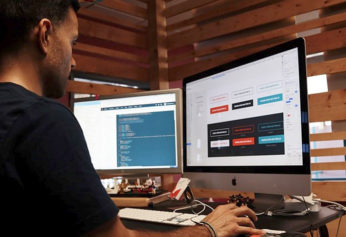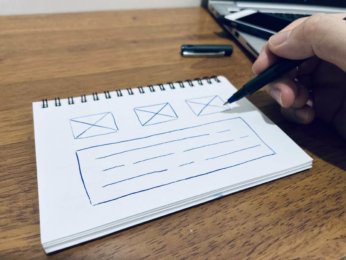In the enlightening piece “Good business will be accessible by all – at least online” on TechHQ, the importance of web accessibility is underscored as a fundamental aspect of website design and development. Recognizing the significance of creating inclusive online experiences and is committed to ensuring accessibility for all users.
Web accessibility should be a primary consideration for architects, developers, and organizations aiming to create high-quality websites and web tools. Tim Berners-Lee, the inventor of the world wide web, emphasized the universality of web access, stating that “access by everyone, regardless of disability, is an essential aspect.”
Ensuring web accessibility means designing and developing websites, tools, and technologies that can be used by anyone, regardless of their abilities or disabilities. It aligns with the basic human right to access information and communications technologies, as recognized by the United Nations Convention on the Rights of Persons with Disabilities.
Moreover, web accessibility not only benefits users with disabilities but also enhances the user experience for non-disabled individuals, including older users and those facing situational limitations. Understands that accessibility is not just about compliance but also about improving overall user satisfaction and driving innovation.
By prioritizing web accessibility, businesses can enhance their brand, extend their market reach, and drive innovation.
Click here to learn more about Total Web Partners’ services.
Article with all rights reserved, courtesy of techhq.com
Photo with all rights reserved, courtesy of depositphotos.com.
If you are thinking about a career as a web designer or web developer, there are some things you should know about the concepts. Even though they share some similarities in terms, they have subtle differences that make them unique. This article will discuss their differences, roles, and how you can choose between them.
Web Development vs. Web Design: The Differences
The main difference between developers and designers is that developers focus primarily on technical aspects, like coding and programming. Designers are responsible for the conceptual and visual work necessary to create a solid UI and UX. In contrast to designers who emphasize appearance and usability, developers emphasize structure and functionality.
Web Designer: This graphic artist designs website layout, functionality, and visual appeal. Web designers are skilled in creative, graphic, and technical areas.
Web Developer: These developers create and maintain the core structure of a website. Web developers are responsible for converting the web design into a functioning website using PHP, HTML, JavaScript, and Python via specific web development services.
Read more: Web Development vs. Web Design: The Differences You Need to Know
https://www.startupguys.net/web-development-vs-web-design/
A new year is typically a time for new ideas, approaches, or ways to make life a little better or more enjoyable. For web designers and users, improved ways to design websites is always high on the list.
In the following post we’ll be addressing 5 new web design trends that address issues like accessibility, UX, and responsiveness as well as 10 pre-built websites from BeTheme that show how to effectively use them.
With 268,000+ sales and a 4.83/5 star rating, BeTheme is one of the world’s most popular and highly-rated WordPress Themes.
5 web design trends to look out for in 2023
In order to improve something, you first have to have an understanding about the things that can impact it, both positively and negatively. For web designers, that “something” is a user’s digital experience and how 5 design trends that can positively impact a digital experience could best be implemented.
- Hoverable iconography
A top web design priority is how to go about creating interfaces that require minimal effort on the part of the user to interact with them, i.e., they are as intuitive as possible. Shortcuts that make things easy for the designer can, however, have the opposite effect on the user – especially when it comes to iconography.
Some icons, especially those used in headers, are so commonplace that any user can interpret their meanings and use them appropriately.
Read more: 5 Web Design Trends to Watch in 2023
Want to know an easy way to speed up and improve the overall performance of your website?
Invest in good hosting.
Ignorance is no longer an excuse for any company to use a cheap web host.
Website performance is a critical element that can help improve your rankings, traffic and conversions.
This guide will cover everything you need to understand about why web hosting is important for SEO.
What is website hosting
A website hosting service provider, or web host, is a service that offers the technology required for a website to be viewed online.
Think of a web host as the home base of your website. Websites or webpages are stored on special computers called servers, and through the server your webpages get connected and delivered to internet browsers.
So, when users want to view your website, all they have to do is type your website address or domain into their browser.
When building a website, companies typically invest a lot of time and resources on design, development, digital marketing and SEO.
But web hosting is one area that tends to be an afterthought.
If you are willing to invest in making sure the website looks good and driving traffic to it, why not also ensure that the actual website is fast, functional and flexible?
Using a high-quality web host can maximize your conversion rates, along with other helpful benefits.
How web hosting benefits businesses
If you want a website for your business, then you will need a web host. Although web hosting is usually left at the back of a business’ mindset, it is crucial for your online presence.
A reliable web host can give your company a variety of benefits, such as:
- Improved site performance.
- Effective data management.
- Enhanced security.
- High uptime.
In short, investing in a reliable web host is wise – and should help grow your business.
Read more: Web hosting for SEO: Why it’s important
As artists, we all have something in common: We need an online portfolio to showcase our (design) skills, talent and creativity. A portfolio website also helps clients or employers to imagine what they can expect when they hire you. But how can you make your portfolio stand out?
Before you start designing your website, make sure to complete these three things:
- Step 1: Think about what goals you want to achieve with your portfolio website.
- Step 2: Pick your best work.
- Step 3: Tell a story.
In other words, decide what information your portfolio must include to speak to potential clients or employers. Then, wrap it into a story about yourself and your work.
Once you got that lined up, let’s start with the actual design of the portfolio website. The following UX design trends will make your website glow up in no time!
Choose a simple and minimal design
Too many visual elements can be overwhelming. A clear and minimal design, on the other hand, improves your website’s navigation. Uncluttered pages make your work shine, as they guide visitors to focus on the elements you want them to focus on. If your portfolio is rather cluttered, consider giving it a simpler design. In some cases, this can improve user experience, which also has a positive effect on search engine optimization and your search engine rankings.
Add interactivity
Today’s websites are more than static pages. Everything is getting faster and more dynamic, and so are websites. Adding interactive elements to your portfolio gives it a unique design and makes it stand out. If you’re rather inexperienced in web design, start out by experimenting with interactive elements such as color shifts or animated fonts.
Create a prominent “About Me” page
The first thing a visitor of your portfolio wants to see is your profile. They want to get to know you and your story. By prominently placing your “About Me” section at the start of your website, you can draw visitors in. They might spend more time on your website, which is also one of the factors that improve your website’s search engine visibility.
Add a headshot
To pep up your profile, you can add a large headshot. This helps your visitors to connect with you and your character upon opening your website. It also signals your visitors that they are looking at a portfolio. Next to your headshot photo, you can place interesting information about yourself and your work.
Whitespace
When it comes to designing the portfolio layout, make sure to add a lot of whitespace between the elements. The current trend of minimalistic design goes hand in hand with a clear layout. By adding lots of whitespace to your portfolio, you can highlight certain works and improve readability.
Read more: Web design trends for creative portfolio websites
The web design industry is evolving rapidly, and if you don’t follow the trends, you’ll get left behind. Try telling today’s generation about flash menus and border ornaments and they’ll stare at you as if you’re some sort of cave person. If you’re thinking of designing a website in 2021, you need to conform to what’s hot and make sure you avoid what’s not. Of course, you can try to get ahead of the curve, but it would be wise to stick closely to mainstream ideas.
Thinking of Creating a Website?
Maybe you’ve just started a business and you want to develop an online presence. Or perhaps you’ve got an established company and you want to modernize or move your pages. Either way, you’ll need to be aware of the design trends in the industry this year.
Anyone can create a free website easily using online tools, with templates that allow you to put everything in the right place and make a professional site that you’re proud of. Experimenting with free designs first could be great for startups, before moving on to paid services to access more advanced features.
Before you begin, it’s wise to do a bit of market research and see what the leaders are doing in your industry. Mirroring the best in the business is a common strategy, and this is how popular trends in web design come about. So, what are the main techniques that seem to be abundant this year?
Horizontal Scrolling
Yes, you read that right. Horizontal scrolling is back in vogue. This was once considered a no-no in web design circles, but the concept is back in style now and proving to be popular. This form of navigating pages wasn’t user-friendly in the past, but it fits perfectly with smartphones and tablets where side swiping is a natural move. It’s also compatible with devices like Apple’s Magic Mouse, which allows users to intuitively move across the page.
Home Societe is one site that has broken the mold in recent times, and its hip layout is one that other designers will want to follow. Instead of navigating down the page, viewers are guided to the right each time. It’s a stunning way to display all the stylish content on the page.
No Set Structure
Square is a perfect example of how web designers are beginning to think outside of the box. This is an incredibly cool page that has introduced a world of new possibilities when it comes to structuring. Instead of clicking on boring tabs, players can navigate around using the cursor and then click on the various links they stumble across on the way. It has gamification feel to it, and it is seriously enjoyable.
Read more: What are the Main Web Design Trends of 2021?
Nowadays, it’s common practice to build a website or app that adjusts its user interface depending upon the browser or the device. There are two approaches to achieve this goal. The first involves creating different versions of your website or app for different devices. But it’s inefficient and can lead to unpredictable errors.
In a search for a reliable, future-proof approach, the responsive — or adaptive — design was coined. It focuses on building a single version of your layout that adapts to different browsers or devices automatically.
In this article, we’ll learn about responsive web design and the fundamental principles that will help you make an awesome website.
Responsive Web Design Ingredients
Responsive web design is not as complicated as it sounds. It’s a set of practices that you can use when writing CSS, not a separate technology that you’ll have to learn from scratch. You might already be following several of these principles without realizing it. You can understand responsive web design by exploring its four ingredients: fluid layouts, responsive units, flexible images, and media queries.
Fluid Layouts
With a fluid layout, you can create web pages that adapt to the current viewport width and height. Common practice includes using the max-width property instead of giving a fixed width to an element. Also, using percentage (%), viewport height (vh), or viewport width (vw) helps improve adaptability that is not possible with pixels (px). So, next time you’re building a layout, make sure to introduce these small changes and start benefitting from responsive design techniques.
Responsive Units
As you move to more advanced CSS, you’ll often see the use of rem and em units for length instead of px units. This is because the rem unit makes it super easy to scale the entire layout. By default, 1rem equals 16px because it’s proportional to the <html> element’s font size, typically 16px. However, you can set 1rem equal to 10px (or any other value) for easier calculations, by adjusting the top-level font size.
Read more: Responsive Web Design Principles
As an online business, your website is a powerful asset and you need it to make a good first impression. By getting up to speed on the latest web design trends, you’ll be on your way to converting one-time browsers into loyal repeat visitors and paying customers. To set your website up for success, here are four WordPress web design trends to follow.
Why it’s important to follow web design trends
When designing a website, there’s always a temptation to stand out by creating something unexpected. While defying expectations may sound like a good idea, unique sites often struggle to provide a strong user experience (UX).
Web design trends exist for a reason. Usually, they represent the most popular and widely used approaches at the current time. Follow these trends, and visitors will immediately know how to interact with your site.
This isn’t to say you can’t bend the rules and inject some of your personality and brand identity into your website. However, before you can get creative, it’s helpful to have a solid understanding of what’s popular in the world of web design.
Four WordPress web design trends to keep an eye on
When it comes to web design, we’ve tracked the latest trends. To keep your website relevant, here are four of the most important developments.
1. Flexible multi-purpose themes
Multi-purpose themes enable you to build practically any kind of website. They often include extensive feature lists and multiple built-in tools. Some popular examples of multi-purpose WordPress themes include Divi and the Avada theme.
Multi-purpose themes are ideal for anyone who owns several websites. Instead of purchasing a different theme for each site, you can use a single multi-purpose theme across all of your domains.
In this way, using multifunctional designs can enable you to solidify your branding and give your entire portfolio a professional makeover.
2. Minimalism and white space
Sometimes less is more. If you take a look at some of the top brands, you’ll see that many websites include white space in their designs. This design trend involves using large white sections between text and images.
White space can create a distinction between different sections. In turn, this can help visitors better understand your content.
If you really want to draw the visitor’s attention towards a particular feature, try creating a slight 3D effect by adding subtle shadows. This technique is also useful for ‘softening’ a page that uses lots of contrasting white space and colourful elements.
Read more: Four WordPress web design trends to follow
No trees are seemingly cut down every time you Google something or read a social media post on your phone or laptop. But websites alone do create emissions—internet usage is responsible for almost four percent of global emissions. That might not seem like a lot, but its equivalent to about the same emissions caused by global air travel. That percentage is predicted to almost double by about 2025 according to a post by Brussels-based energy magazine Energuide. And internet usage is on the rise– as COVID shut down the world last spring pushing many jobs and education online, internet usage went up as high as 40 percent, Yale News reported.
“The pandemic-related switch to digital has important environmental benefits, such as the reduction of travel-related carbon emissions, but the transition to a more digitally-centered world is not as clean as one might think,” Kaveh Madani, the Henry Hart Rice Senior Fellow at the Council on Middle East Studies at Yale’s MacMillan Center who led a study that outlined the internet’s environmental impacts, told Yale News.
The emissions caused by websites comes from the hosting company that ensures that websites are up and running when users search for them, on their server. By working with an environmentally-sound server like GreenGeeks, A2 Hosting, and HostPapa that focuses on renewable energy or lowering their energy usage, websites become more sustainable, Wired UK reported. Something as simple as using fewer images on a webpage also helps lower emissions. Another way to lower emissions is to have simply designed websites with little to no moving images like gifs.
“Images are the single largest contributors to page weight. The more images you use and the larger those image files, the more data needs to be transferred and the more energy is required,” Vineeta Greenwood, account director at design agency Wholegrain Digital told Wired UK.
Another aspect of creating more sustainable websites means raising awareness, or letting servers or customers in need of new web design know that it’s even an option for them. Some major search engines like Google have pledged to lower their tech centers’ water usage and to rely on more sustainable energy to run their search engines and other online products like Gmail and Google Docs.
Baruch Labunski, CEO of Toronto-based SEO company Rank Secure, explains that when many clients work with the company to have their websites designed, they don’t often think about sustainability. Companies like Rank Secure make a point to have sustainability as part of their process when working with businesses who want help with web design by relying on more sustainable data centers.
Read more: Your website could be doing the environment dirty. Here’s how to clean it up.








